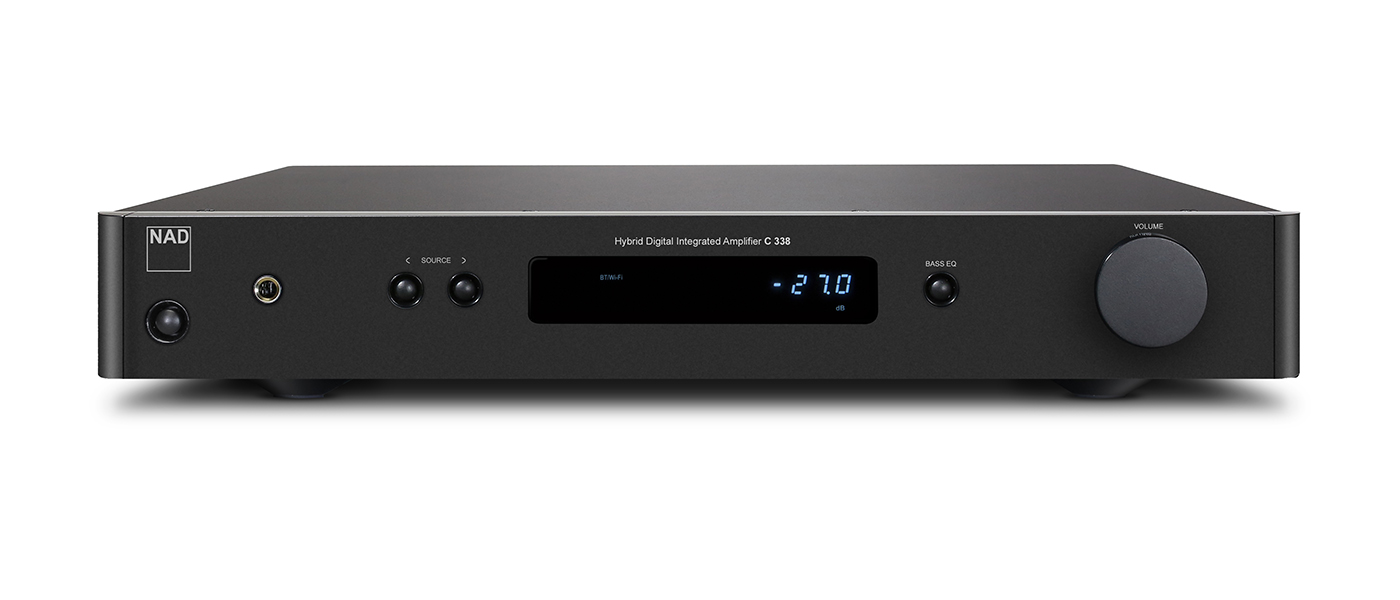Not only are many enthusiasts storing vast libraries of downloaded music on their computers, there are those who simply want to listen to the radio or connect to a service like Spotify for easy access to thousands of songs. The NAD M32 Direct Digital Amplifier can do all of those things while delivering the fantastic sound the Masters Series is revered for.
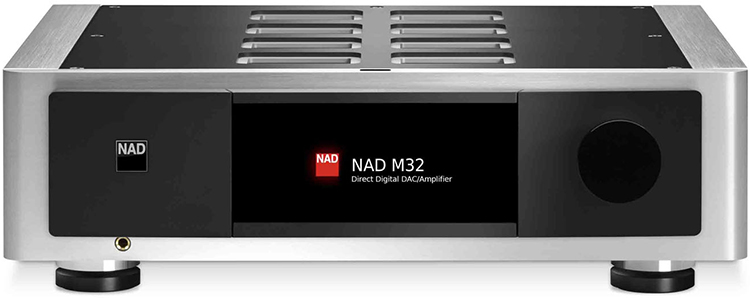
NAD M32 Direct Digital Amplifier
- NAD M32 Direct Digital Amplifier
- Two-channel integrated amplifier
- Direct Digital technology
- BluOS module, streams via Wi-Fi and Bluetooth
- Modular Design Construction (MDC) supports future upgrades
The NAD M32 Direct Digital Amplifier is a true bridge product. On one hand, it’s a high-end two-channel integrated amplifier that employs some impressive technology from the Masters Series. But when you plug in the optional BluOS module, it becomes a fully-capable streaming player that can pull in content from your network’s library, the Internet, or anything with Bluetooth capability.
Type:
2-channel integrated amplifier w/DAC
Continuous Output Power:
150W into 4/8 Ohms
Dynamic Power:
190W/8 Ohms, 380W/4 Ohms, 440W/2Ohms
Distortion:
<0.005% (20Hz-20kHz, 500mW @ rated power)
Maximum Output Current:
>18A
Signal to Noise Ratio:
>95dB @ 1W, 124dB @ 150W, A-weighted
Damping Factor:
800
Channel Separation:
>90dB (10kHz, 4 Ohms, 1/3 rated power)
Input Impedance:
Coax – 75 Ohms, AES/EBU – 110 Ohms
Sample Rate:
32kHz-192kHz
Card Cage:
Up to 4 MDC input modules
Inputs:
3 x RCA, 2 x coax, 2 x Toslink, 3 x USB (1 x async), Bluetooth, Wi-Fi, LAN
Outputs:
1 x coax, 1 x optical, 1 x RCA
Speaker Terminals:
Five-way binding posts, bi-wire capable
Control:
IR, RS-232
Dimensions:
17 1/8” x 5 ¼” x 15 5/16" (WxHxD)
Weight:
17lbs
Warranty:
3 years
NAD M32 DirectDigital Amplifier Price:
$3999, BluOS Module – $399
Company:
SECRETS Tags:
NAD Masters Series, M32 Direct Digital Amplifier, Integrated Amplifier, BluOS, Amplifier Reviews
Linkbacks:
If you’ve followed NAD’s history even a little, then you know it’s focused on sound quality above all. The Masters Series is the pinnacle of that mantra and as such, employs the most advanced technologies. I covered the M17 & M27 surround separates in 2014 and found they delivered some of the cleanest sound I’d yet heard from a multi-channel setup. By keeping the signal in the digital domain right up to the speaker outputs, the M32 puts out phenomenal sound with no perceptible distortion and a damping factor that simply defies description.
To that, the M32 adds Modular Design Construction (MDC) in the form of four card cages that accept different input modules. My sample shipped with traditional digital inputs along with a BluOS streaming module that supports Bluetooth and Wi-Fi. This is a box that can easily grace a high-end rack or a living room that simply thirsts for great sound delivered conveniently. It looks to be the ultimate bridge product. Let’s take a look.

The M32 Direct Digital Amplifier is part of NAD’s Masters Series of audiophile components. As such, it’s packed with their most advanced amplifier technology that keeps all signals in the digital domain right up to speaker outputs. I first saw this approach in the M27 multi-channel amp reviewed back in 2014. The M32 uses the latest Direct Digital Feedback Amplifier components which NAD builds under license from Cambridge Silicon Radio. While technically a Class D amp, it’s more akin to a DAC that can drive speakers. Many companies call their Class D products “digital amps” but they are not. In those cases, Class D refers to the switching method. The signal itself remains in analog form from input (or DAC section), through processing (volume & tone control), to speaker output.
Secrets Sponsor
The M32 is a true digital amplifier. The signal comes in the coax, optical, USB, Bluetooth, or Wi-Fi inputs and is processed without conversion until it reaches the speaker outputs. By eliminating multiple cascading stages of analog amplification, noise and distortion are almost non-existent. The signal path has extremely low impedance and is very short which contributes to a super-high damping factor. To say this amp is responsive would be an exercise in understatement.
All the functions of the preamp, namely volume and tone control, are performed by software algorithms. This makes the grain introduced by analog potentiometers a thing of the past. And tone control is handled without any change in phase or distortion. The software filters also enable a built-in crossover which can be used for a separate subwoofer.
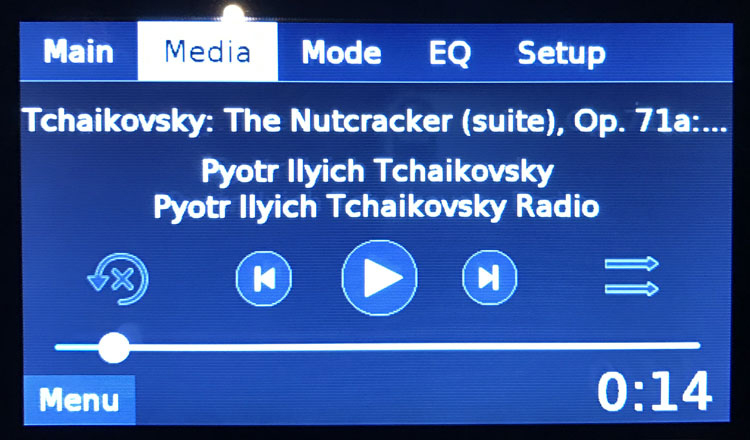
Physically, the M32 Direct Digital Amplifier is minimalistic box with a lovely alloy faceplate that features an all-glass touchscreen at the center. To the right is a large volume knob with a high-end feel and no detents. Resolution is .5dB. There is no power switch in the traditional sense but a small touchpad at the top-center wakes the unit from standby, which only draws half-a-watt. Power status is indicated by the NAD logo at left, white for on and orange for off. Additionally, you can cut all the juice with a toggle switch around back.
Secrets Sponsor
Up top are generous vents though you won’t find too much heat coming from them. If you place a component on top of the M32, make sure it has sufficient clearance. Speaking of feet, NAD has included large pucks that install magnetically on the bottom. The pucks have generous rubber pads which won’t mar delicate surfaces. If you choose not to use them, the installed feet are cone-shaped with gently-rounded tips.
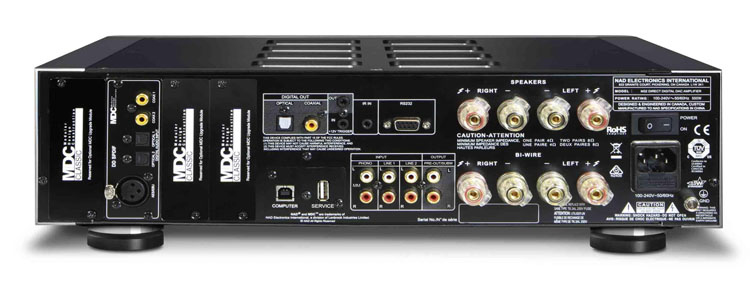
Around back is where things get interesting. There is a traditional set of analog inputs; three RCAs (one is for the moving-magnet phono stage), and an RCA output. Digital inputs include one USB upstream, plus two more downstream ports on the BluOS module. That MDC card also includes a Bluetooth antenna and a Wi-Fi dongle that plugs into one of the USB ports. Traditional digital inputs come on the second included MDC card and offer two each of coax and optical along with an AES/EBU port. There are two unoccupied card slots for which there is currently only an HDMI board available.

The remote is one of the heaviest and beefiest handsets I’ve ever seen. It’s made from a single piece of extruded aluminum with a plastic faceplate. It weighs more than some DVD players I’ve seen, nearly a pound. It’s designed to control other components besides the M32 and has mode switching buttons at the top for that purpose. It’s also fully backlit which makes it great for home theater environments. My only complaint is the aluminum has a few sharp edges which could mar furniture.
One can use the M32 as a traditional two-channel integrated amp by simply connecting sources like a turntable, optical disc player, or tuner. And if you buy it without the BluOS module, that’s exactly what you’ll be doing. You can also connect a computer to the USB upstream port. For this review, I hooked my Oppo BDP-93 up via coax to engage in a bit of two-channel CD listening.
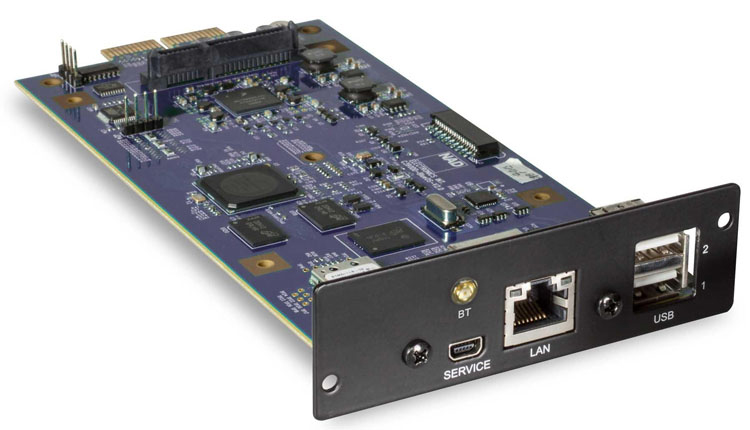
But this limits one to their physical media library although you could hook up a steaming box with a coax or optical output to the M32. The best way to enjoy streamed content though, is to add in the BluOS module ($399) my sample shipped with. This opens up a whole new world of possibilities. It offers Ethernet, Wi-Fi, and Bluetooth input and is fully-controlled by a smartphone or tablet app. It should appeal to audiophiles with its 24-bit/192kHz capability plus it can play MQA formats from the premium Tidal music service. The possibilities become almost limitless when you use the M32 this way. And lest you wonder why one would stream compressed content to a $4000 amplifier, you won’t wonder after you’ve had a listen.
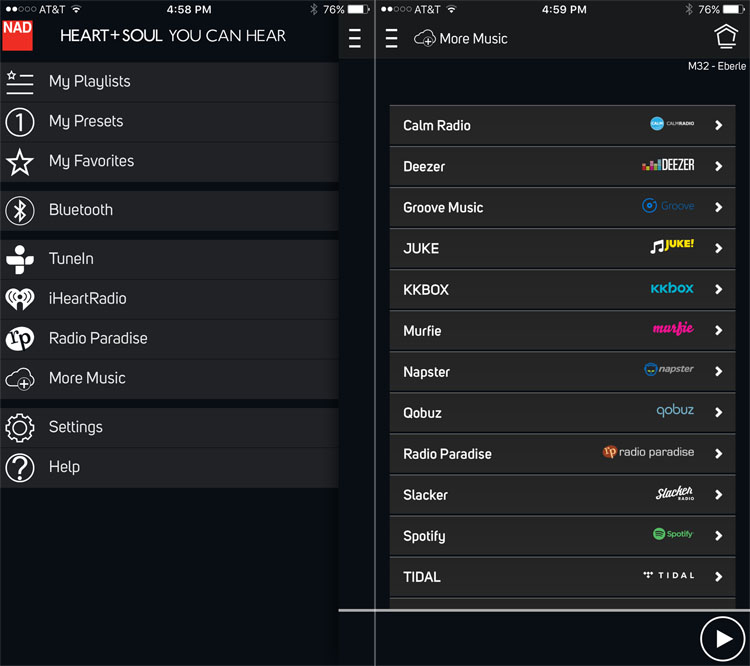
Setting up BluOS first requires that you install said app on your smartphone or tablet. I used an iPhone 7 Plus for this. The interface is a bit clunky but I was able to figure it out after a couple of listening sessions. The first order of business is to get the M32 on the network. That simply required me to go the Wi-Fi settings on the iPhone and select it. Returning to the BluOS app, it initiated a software update which took about 10 minutes to complete. You can monitor its progress on the front panel. By the way, the touchscreen? It’s cool for sure but I found I could get things done faster with the remote’s navigation keys.

Once the player is on the network, you can select from multiple content sources. All the major online providers are there or you can stream via Bluetooth from your preferred device. I was able to send music right from my phone to the M32. The real fun begins when you sign up for a service like iHeartRadio. Let the music surfing begin! I spent several afternoons checking out radio stations from all over the world, and a few local ones too.
To evaluate the M32, I connected my reference Axiom LFR1100s to the main set of speaker terminals. The binding posts are some of the nicest I’ve ever seen and can easily accommodate any type of cable termination, or bare wire if you’re so inclined. Since the Axioms normally require four channels of amplification, I listened to just the front driver arrays. This effectively turns them into a pair of M100s. I’ve used this approach before and it still provides a full-range speaker with a super-wide soundstage.
When I evaluate audio components, I ask myself two questions, can I place the instruments in a 3D virtual space? And, can I imagine the performance space in my mind? The second question comes from my background as a performer. I’ve played in venues ranging from baseball stadiums (no joke, we played near third base with the audience in the stands before us) to Carnegie Hall. Orchestral recordings are nearly always created in empty concert halls though newer releases are taken from live concerts with an audience in attendance. I want to be able to tell the difference between a great hall or a studio. I want to know if there’s an audience there or not. I also want the instruments to surround me rather be up on a stage beyond reach.

I always start with a few old London Digital CDs of the Chicago Symphony playing Beethoven and Brahms symphonies. These performances are very musical and organic but the mix is very string forward. It’s as if the microphones were placed only at the front of the stage. I always feel as though I’m sitting in the first row, close enough to identify the kinds of shoes worn by the first violins. The M32 captured that essence just as many components have before it, but this time, the soundstage was much wider. While brass and woodwind instruments still came from a distance, I could clearly hear the details of individual tone colors and even familiar players. It was easy for instance, to differentiate between principal bassoon Willard Elliot’s sound versus the second desk player, John Raitt.
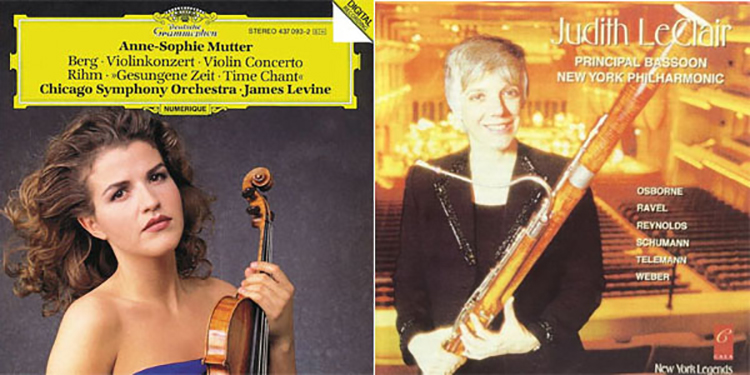
I decided to try a newer recording of Anne-Sophie Mutter playing Alban Berg’s Violin Concerto. This is a very complex work with lots of interaction between the soloist and different sections of the orchestra. Though the mix keeps the violin front and center, you can clearly hear individual instruments and sections weave their parts around the solo in a fair and equal manner. To me, this is a far better test of detail than the classical guitar or piano works used in many audio reviews. The M32 really shined with this material. Transparency was better than I’ve ever heard and the ambient cues of Chicago’s Orchestra Hall were crystal clear. Much of this work is a chamber piece, right down to the Bach choral played by the clarinets near the end of the second movement. The M32’s complete lack of audible distortion, invisible noise floor, and terrific response breathed new life into an already reference-level CD.
I also tried a more pared-down performance with bassoonist Judith LeClair’s New York Legends recital disc. Her sound is quite distinctive and embodies tremendous depth with a huge array of partials and colors. The performance came alive in front of me right down to the clicking of her keys and the pianist’s feet working the pedals. I was inspired to listen to the entire disc and it was over before I even realized the time.
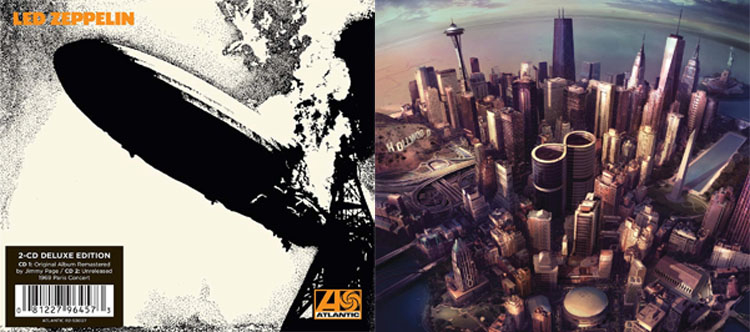
To check out the M32’s rock chops, I went for some more honest analog-based material. That usually means oldies or Foo Fighters so I started with the Led Zeppelin re-masters. The vintage warmth was there, which is to say the recordings are slightly veiled. But reverb and other effects have a much more realistic feel than today’s computer-generated stuff. Robert Plant and friends made me feel as if they were playing in Madison Square Garden and I was the only member of the audience. It was a private arena rock concert right in my listening room.
The latest Foo Fighters disc, Sonic Highways, delivers more of a club feel but still has all the tactility and honesty of much older material. Dave Grohl stays true to tradition by doing much of his recording through analog consoles and mastering on reel-to-reel tape. Again, the M32 provided its signature wide soundstage and excellent ambient detail. There are few components that draw me in like this amplifier. Even though I’m familiar with NAD’s approach to sound, the Direct Digital amp takes that experience to a new level.

THE NAD’S M32 DIRECT DIGITAL AMPLIFIER delivers high-end audio quality at a relatively modest price. It also excels as a lifestyle component with its BluOS module.
- Direct Digital technology delivers super-clean and distortion free sound
- Wide soundstage with tremendous detail and dynamic range
- Great sound from physical media and streamed content alike
- Unparalleled build quality
- BluOS module opens up a world of possibilities
- More intuitive BluOS app
I’ve heard enough high-end audio components to know that it takes something special to really excite me. The NAD M32 Direct Digital Amplifier is one such component. Even though I’ve spent a lot of time with NAD gear in the past, and even experienced similar technology in the M17/M27 separates, the M32 takes everything good about those products to even greater heights. With its novel approach to signal processing, NAD has redefined my perception of clarity and soundstage in a major way.
My mantra with both audio and video gear is to seek out the most neutral parts I can find. My choice comes down to whatever reproduces the original material with the least amount of processing and alteration. The M32 is a supremely neutral component. But it manages to improve poor-fidelity recordings at the same time, which is something I didn’t believe was possible. But evidently its perfect signal-handling results in a wider soundstage. While that sounds simplistic, it’s the quality that most won me over. Obviously my most-familiar recordings still had something to offer that I hadn’t heard before from other components.
And before I get too carried away with my comments on sound quality, I should conclude with a final mention about the sheer coolness of the BluOS module. With the addition of this card, the M32 remains an audiophile piece but gains a level of convenience that makes it the equal of any lifestyle component at any price. It’s not always ideal to shuffle CDs or even to create playlists on your connected laptop. BluOS makes it easy to just tune in a bit of Internet radio or your favorite streaming service when you just want some background music to liven the party or soothe your evening.
Either way, the M32 Direct Digital Amplifier is a winning design that’s been perfectly executed. It receives my highest recommendation.


